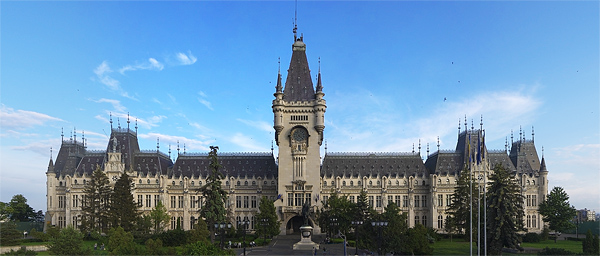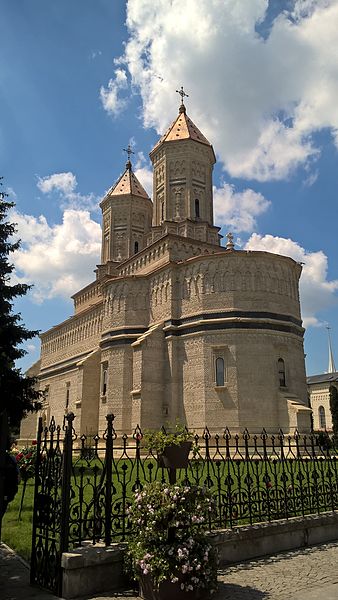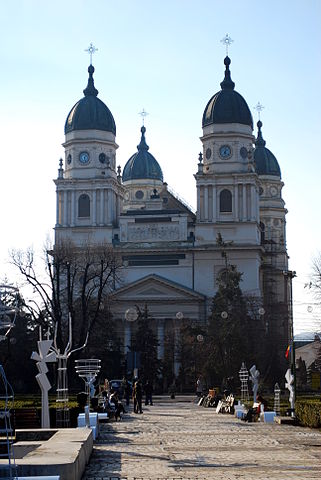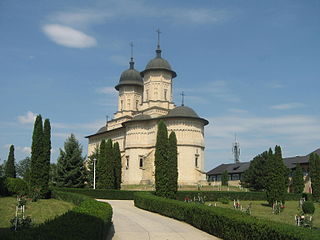European Symposium on Religious Art Restoration & Conservation
Venue
The symposium will be held in Iași, at the Faculty of Chemical Engineering and Environmental Protection, located in 73 Prof. dr. docent Dimitrie Mangeron Street , Iași, România.
How to reach us: The routes listed below allow reaching the Faculty of Chemical Engineering and Environmental Protection, the congress location.
By airplane: from Iași Airport (from Iași airport you can take the bus towards downtown). From Otopeni Airport you can take an internal flight to Iasi. For further information about the internal flight you can visit the web site http://www.aeroport.ro/.
By Car: WGS coordinates E: 27 36'11.13" / N: 47 09'17.58"
For further details please contact the conference secretariat
Unirea Hotel (****)
Piaţa Unirii Street No. 5, 700056 Iaşi, Romania
e-mail: rezervari@hotelunirea.ro; Tel: 004 0232 205000; Fax: 004 0232 205026
Offering free Wi-Fi, Unirea Hotel & Spa is located in the centre of Iasi at Union (Unirea) Square. It provides free access to the spa area featuring a heated pool, sauna, Turkish bath, hot tub and a gym. The non-smoking rooms of Unirea Hotel & Spa are fitted with flat-screen TVs with international TV channels. For your comfort, bathrobes and slippers are provided. Pamper yourself to various massage and beauty treatments or get active with the aerobic programmes on site. For smoking guests, a designated smoking area exists at this hotel. The Panoramic Restaurant is on the 13th floor and has unique views over the city. Traditional Romanian cuisine as well as international specialities are served. The Palace of Culture is 1.5 km away and the Metropolitan Cathedral is 1 km from the Unirea. Iaşi Airport is reachable in a 15-minute car drive from the hotel, and the local railway station is a leisurely 15-minute walk away. This property is also rated for the best value in Iaşi! Guests are getting more for their money when compared to other properties in this city.
Hotel Rooms: 186
-------------------------------------- .
Hotel Moldova ( ***)
Anastasie Panu Street No. 31, 700028 Iași, România,
e-mail: office.iasi@unita-turism.ro; Tel: 004 0372 791748; Fax: 004 0232 219621
Centrally situated in Iasi nearby the Saint Nicolae Domnesc Church, Hotel Moldova provides free wired internet access, free parking and a modern indoor swimming pool with a gym and sauna. All rooms feature air conditioning, cable TV and a minibar. A seating area is available as well. The bathrooms comprise showers or bathtubs as well as hairdryers. Guests can sample international dishes at the restaurant and on the terrace. Coffee and other beverages are served at the café of the Moldova. The Moldova is 3 km away from the Main Train Station, which can be easily accessed by public trams. The Romanian Railroad ticket office is a few minutes' walk away.
.
Tudor T23 Hotel (***)
Ciurchi Str. 30, 700313 Iaşi, Romania
email: rezervari@hotelt23.ro; Tel: 004 0724 220042; 004 0754 329027; 004 0232 220043
Typical Romanian cuisine can be sampled at Hotel Tudor Palace’s restaurant in Iaşi. The hotel is situated 500 m from a shopping centre and offers rooms with air conditioning and free Wi-Fi. Each of the rooms comes with cable TV and a minibar. A bathroom with free toiletries and a hairdryer is standard in every room. A terrace, where you can dine in good weather conditions, is provided and you can enjoy refreshing drinks at the on-site bar. Free private parking is possible at the Tudor Palace Hotel and the closest bus and tram station is a 5-minute walk away. The main train station is 4 km from the property. The Ion Creangă Memorial House can be reached within 5 minutes by car and the Golia Monastery is 1.5 km from Hotel Tudor Palace.
The hotel is about 3 minutes’ walk to the congress location.
The Palace of Culture is an edifice located in Iaşi, Romania. The building served as Administrative and Justice Palace until 1955, when its destination was changed, being assigned to the four museums nowadays united under the name of Moldavia National Museum Complex. Also, the building houses the Cultural Heritage Conservation-Restoration Centre, and hosts various exhibitions and other events. The Palace of Culture is listed in the National Register of Historic Monuments.
The construction, started in 1906-1907, was partly built on the old ruins of the mediaeval Princely Court of Moldavia (1434), and partly on top of the foundations and first levels of the former neoclassical style palace, dated to the time of Prince Alexandru Moruzi (1804-1806, architect Johan Freywald), rebuilt by Prince Mihail Sturdza (1841-1843, architect Nicolae Singurov), and dismantled in 1904-1906. It was from this latter building that the Palace inherited the legend of the 365 rooms, as many as the days within one year. The Romanian architect I.D. Berindei was assigned to plan the building and he designed it in flamboyant Neo-Gothic style. During World War I, the construction works halted due to the limitation of resources, but the unfinished building sheltered Romanian and Russian troops, and different public institutions and military hospitals. The monument was finally completed on 11 October 1925, and officially inaugurated, one year later, by King Ferdinand I of Romania. Until 1955, the building housed the County Law Court, and other public institutions. During World War II, the Palace sheltered German troops, and then Soviet troops. Between 1975 and 1977 the wood bridging from the last floor was replaced with a cement one, fixed with steel netting. The new bridging sustained the monument during the earthquake of 1977, but the bridging from the first floor, the walls, the ornaments and the relief works were affected. A large-scale restoration project, considered one of the most complex in Romania since 1990, began in 2008. The partial completion of works is scheduled for April 2016.

Mănăstirea Trei Ierarhi (Monastery of the Three Hierarchs) is a seventeenth-century monastery located in Iaşi, Romania. The monastery is listed in the National Register of Historic Monuments and included on the tentative list of UNESCO World Heritage Site.
The church was erected between 1637 and 1639, in the Moldavian capital, in honour of three saints (Basil of Caesarea, Gregory of Nazianzus, and John Chrysostom), and was blessed by Bishop Varlaam. In 1640, Prince Vasile Lupu, the renowned defender of the Orthodox Church, set up here the first printing press in Moldavia and the Vasilian College, a higher education institute. In 1643, the first volume ever printed in Moldavia was issued in Iași. The Trei Ierarhi Church was dedicated by Vasile Lupu to the 20 monasteries on Mount Athos. Several Romanian royal figures are buried inside the church: Tudosca (Vasile Lupu's first wife) and Ștefan Vodă, their son; prince and scholar Dimitrie Cantemir (1673–1723); and Alexandru Ioan Cuza, the first ruler of the united Romanian principalities (1859–1866). The church became renowned for the extraordinary lacery in stone which adorns the facades, from bottom to the top of the derricks. One can count over 30 non-repeating registers of decorative motives. Western architectural elements (Gothic, Renaissance) combine with the Eastern style, of Armenian (Khachkar), Georgian, Persian, Arabian or Ottoman inspiration, in a totally bold conception, whose result is a harmonious ensemble. The effusive scenery makes the church resemble a shrine of architectonic proportions, especially conceived to protect the Sfanta Cuvioasa Parascheva's relics (1641). After the 1882 restoration, the original fresco was derusted, some fragments still being kept today in the monastery's museum. Near the church one can find the Gothic Hall, which shelters a religious art museum. It has, among other things, objects related to the history of the monastery. In the gate's tower (which today no longer exists), that served as belfry, Vasile Lupu had installed a huge horologe, the first public use clock in Romanian Principalities (1654). During the 1882 restoration, the whole mechanism was disassembled and transported to France, where it remained.

The Iași National Theatre is the oldest national theatre and one of the most prestigious theatrical institutions in Romania. In 1956, it was given the name of the renowned Romanian playwright and poet Vasile Alecsandri.
One of the first theatrical performance in Romanian language, was organized by Gheorghe Asachi, and held in the capital of Moldavia, Jassy/Iași, on 27 September 1816. In 1834, a Romanian production took place in Iași on the stage of the Théâtre de varieté, built in 1832 for the French Fouraux troupe. The National Theatre was founded on 15 May 1840, as the Great Theatre of Moldavia, when the Romanian language troupe, led by Costache Caragiali, was united with the French troupe, under a single direction of Vasile Alecsandri and the management of Costache Caragiali. On 22 December 1846, a new audience hall was inaugurated in the former mansion of Prince Mihail Sturdza, on the Hill of Copou.
The Metropolitan Cathedral is the seat of the Romanian Orthodox Archbishop of Iaşi and Metropolitan of Moldavia and Bukovina, and the largest Orthodox church in Romania. It is dedicated to Saint Paraschiva, to the Presentation of Jesus and to Saint George. Its form was inspired by the late Italian Renaissance style (Trinità dei Monti in particular), with Baroque elements dominating the interior and exterior decorative features. The Metropolitan Cathedral is listed in the National Register of Historic Monuments.
Two churches previously stood on the site: the White Church (15th century) and the Presentation Church (17th century). On 8 August 1826, prince Ioan Sturdza signed a decree ordering construction of the cathedral; Metropolitan Veniamin Costache laid the cornerstone on 3 July 1833 and guided construction in its early years. Work began in 1833, using a neo-classical design by Viennese architects Gustav Freywald and Bucher, and continued at a rapid pace until 1841, in the latter years under the Russian architect Mihail Singurov. In 1839, serious cracks had appeared on the large central arch, which collapsed on 23 May 1857, taking the interior columns with it. Various solutions were attempted (in 1840 Singurov replaced the brick ceiling with wood, for example), but the building remained ruined for decades. At the urging of Metropolitan Iosif Naniescu (1875-1902), the newly independent Romanian state decided to start the restoration work of the cathedral. A new cornerstone was laid on 15 April 1880. Architect Alexandru Orăscu, rector of the University of Bucharest, designed new plans that added two rows of massive pilasters to the interior, creating a rectangular basilica shape, with a central nave and two smaller side naves. The four detached side spires were kept, but the large central dome was eliminated and replaced with a system of four semicircular sections, separated by transverse arches. Gheorghe Tattarescu painted the icons and decorative elements in a style that respected Orthodox norms but also showed a Renaissance influence. The four Biblical scenes above the central nave, the saints' faces and the decorative compositions all show an Italian neo-classical rigor, to which the artist had been exposed during his studies at Rome's Accademia di San Luca. This creates harmony between the painting and the architectural style. The stained glass was worked in Munich and redone after World War II, under Metropolitan Justinian Marina. Two valuable icons painted in the 16th century are kept inside; they depict Christ Pantocrator and the Madonna and Child. The eastern façade has six columns on a high stone base, above which is a high bas-relief of the Presentation. The western façade has eight columns separated by the entrance, above which is a curved mosaic also showing the Presentation; above that is a stone carving of Saint George. The roof is decorated with zinc fleurons and stylized crosses adorn both the roof and the four spires. The cathedral was consecrated on 23 April 1887, in the presence of King Carol I and Queen Elisabeth, who had donated large sums for the project. In 1889, the relics of Saint Paraschiva, patron saint of Moldavia, were brought from Trei Ierarhi Monastery and continue to attract crowds of pilgrims, particularly on her feast day (October 14). These are located on the right side of the vestibule, as are those of Veniamin Costache.

The Cetățuia Monastery is a Romanian Orthodox monastery located in Iaşi, Romania. The monastery is listed in the National Register of Historic Monuments.
Located on the top of Cetăţuia Hill of the old Moldavian capital, the monastery was built by Prince Gheorghe Duca in the 17th century. The monastery is surrounded by fortifications with towers on the corners, and it provided refuge during enemy siege or full-scale invasions. The name itself Cetăţuia means citadel or fortress in Romanian. The uniqueness of Cetățuia Monastery consists in the fact that the entire ensemble of monastic architecture has been preserved. A special place is the palace destined to the lodging of the prince, a fortified building characteristic to the 17th century and the kitchen or, according to other opinions, the Turkish bath which is the only construction of this kind that has been preserved within a monastic ensemble. In addition there is also a gothic hall, a museum of medieval art, a tower called “Pilgrim’s Dinner” from where one can admire the panorama of Iași and its famous wine cellars with wine obtained from its own vineyard.

